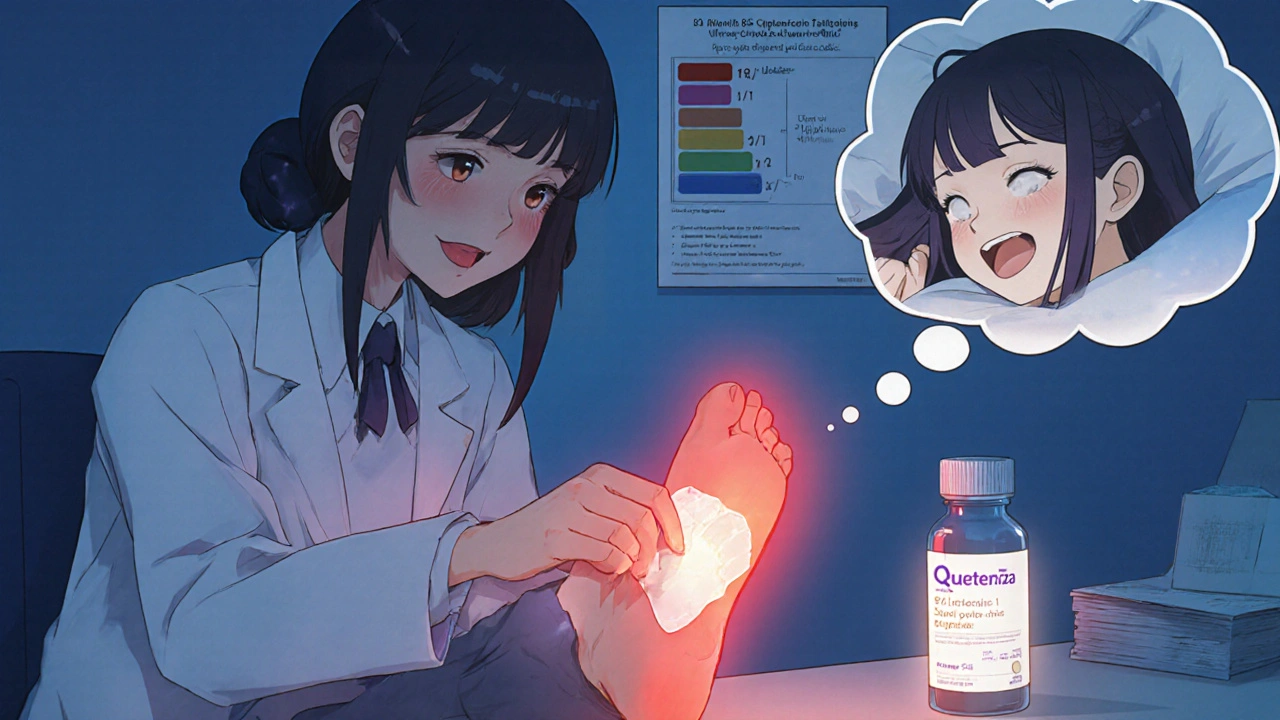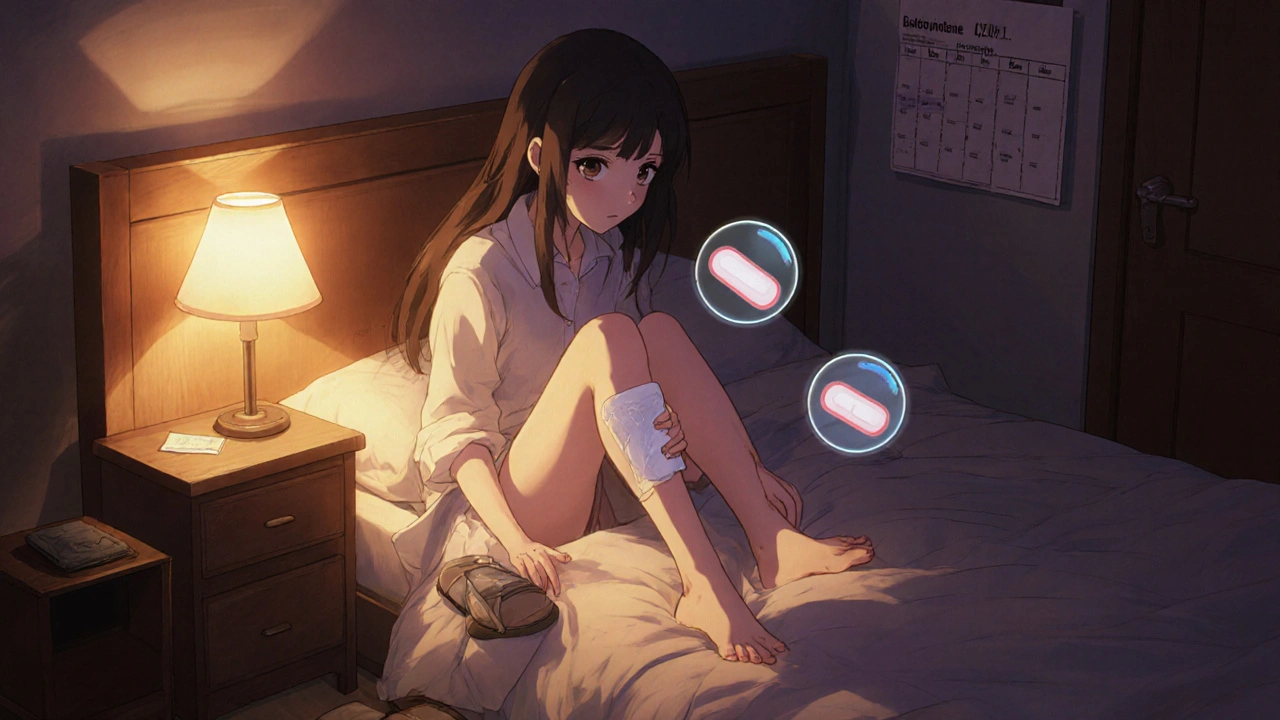Living with diabetic neuropathy pain isn’t just about discomfort-it’s about losing control over your daily life. You might feel burning, tingling, or sharp needles in your feet, especially at night. The worst part? No medication can fix the nerve damage. But you can reduce the pain, protect your feet, and keep moving. This isn’t about miracle cures. It’s about real, proven steps that work for most people.
What Medications Actually Help With Diabetic Neuropathy Pain?
There are only four FDA-approved drugs specifically for diabetic neuropathy pain: duloxetine, pregabalin, tapentadol extended-release, and the 8% capsaicin patch. But in practice, doctors use more. The key is finding what works for you, not what’s most popular.Duloxetine (Cymbalta) is often the first choice. It’s not just a painkiller-it helps with depression, which affects up to one-third of people with nerve pain. At 60mg daily, it reduces pain by 30-50% in most who respond. Side effects? Nausea, dry mouth, and sometimes weight gain. But for many, the mood lift makes it worth it.
Pregabalin (Lyrica) works fast-some feel relief in 48 hours. It’s great if pain keeps you awake or causes anxiety. But it comes with trade-offs: dizziness in 30% of users, sleepiness in 20%. It’s also expensive. Even with insurance, a 90-day supply can cost $300. Generic gabapentin is cheaper-around $4 for 90 pills-but it needs to be taken 3 times a day, which makes people skip doses.
Tricyclic antidepressants like amitriptyline are still used, even though they’re not FDA-approved for this use. They’re cheap and effective, especially at night. But they cause dry mouth, constipation, and can mess with heart rhythm in older adults. If you’re over 45, your doctor should check your ECG before starting.
Topical treatments like the 8% capsaicin patch (Qutenza) are underused. One user on Reddit said it cut their foot pain by 70%. The catch? Applying it feels like fire for 30-60 minutes. It’s done in a clinic, not at home. For milder pain, 5% lidocaine patches are gentler and can be used daily.
Don’t expect opioids to be your answer. The CDC warns against them for long-term nerve pain because of addiction risk. Tramadol is sometimes used as a last resort, but only if nothing else works. And never use NSAIDs like ibuprofen regularly-they raise your risk of kidney damage by more than double if you have diabetes.
How to Choose the Right Medication for You
There’s no one-size-fits-all. Your doctor should consider your other health issues. If you have heart disease, avoid TCAs. If your kidneys are weak, pregabalin and gabapentin need lower doses. If you’re depressed, duloxetine might be your best bet. If you’re on other meds, watch for interactions.Start low, go slow. No one should jump to the full dose. Duloxetine usually starts at 30mg for a week, then goes to 60mg. Pregabalin begins at 75mg once a day, then increases every few days. Give each drug 4 to 8 weeks to see if it helps. If you’re not getting at least 30% pain relief by week 12, it’s time to switch.
Cost matters. Generic duloxetine costs less than $16 for 90 pills. Pregabalin? Around $379. Gabapentin is $4. If you’re paying out of pocket, that difference changes everything. Use GoodRx or similar apps to compare prices before filling your prescription.
Foot Care Isn’t Optional-It’s Lifesaving
Pain in your feet is a warning. But the real danger isn’t the pain-it’s the numbness. When nerves die, you stop feeling cuts, blisters, or infections. That’s how foot ulcers start. One in six people with diabetic neuropathy will get a foot ulcer within five years. And ulcers can lead to amputations.Check your feet every single day. Use a mirror or ask someone to help if you can’t see the bottom of your feet. Look for redness, swelling, cuts, blisters, or toenails growing into the skin. Wash feet daily with lukewarm water-not hot. Dry them completely, especially between toes. Moisturize, but don’t put lotion between toes-it traps moisture and breeds fungus.
Wear shoes that fit. No barefoot walking-not even indoors. Even a small step on a hot floor or a sharp rock can cause damage you won’t feel. Get custom diabetic shoes if you have foot deformities. Medicare and many private insurers cover them if your doctor prescribes them.
Trim toenails straight across. Don’t cut into the corners. See a podiatrist every 3 to 6 months. They can remove calluses safely and check for early signs of nerve damage. Your doctor should do a 10g monofilament test once a year-it checks if you can feel light pressure on your feet.

What to Avoid
Many people try home remedies that don’t work-or make things worse. Apple cider vinegar, essential oils, or electric nerve stimulators sold online? No solid proof they help. Some can irritate skin or cause burns.Don’t soak your feet. It dries out the skin and increases infection risk. Avoid heating pads or hot water bottles-your numb feet can’t feel if they’re burning. Don’t ignore a blister or cut just because it doesn’t hurt. A small sore can turn into a deep infection in days.
Also, don’t delay treatment. If your pain gets worse, or you notice a wound that won’t heal, see your doctor immediately. Waiting can cost you your foot.
What’s New in Treatment?
The field is moving. Mirogabalin, a new drug approved by the FDA in 2023, shows promise with fewer side effects than pregabalin. Early results from the DAPA-NEURO trial suggest SGLT2 inhibitors (like dapagliflozin), which are used for blood sugar, might actually protect nerves over time. Results are expected in late 2024.Genetic testing is starting to help too. Some people’s bodies process duloxetine differently based on their genes. If you’ve tried three meds and nothing worked, ask if genetic testing for CYP2D6 enzyme activity is available. It could save you months of trial and error.
Combination therapy is also gaining ground. One 2022 study found adding N-acetylcysteine to pregabalin doubled pain relief compared to pregabalin alone. It’s still experimental, but it shows where the future is headed.

Real Stories, Real Outcomes
One 62-year-old man in Texas tried gabapentin, amitriptyline, and tramadol. Nothing worked. He started duloxetine at 30mg, increased to 60mg over three weeks. By week 10, his pain dropped 65%. He says he sleeps through the night for the first time in years.A woman in Oregon used the capsaicin patch. The application hurt like hell-but after, her foot pain dropped from 8/10 to 2/10. She says it’s worth the burn. She gets it done every 3 months at her doctor’s office.
But not everyone succeeds. One Reddit user said he stopped amitriptyline after two weeks because his mouth was so dry he couldn’t swallow. Another couldn’t afford pregabalin and switched to gabapentin-but took it only twice a day instead of three, so it didn’t work. These stories aren’t failures. They’re lessons.
What You Can Do Today
Start with your feet. Look at them right now. Are there any red spots? Cuts? Swelling? Write down what you see. If you’re not checking daily, start today.Review your meds. Are you on something that’s too expensive? Too many side effects? Talk to your doctor about switching to generic duloxetine or gabapentin. Ask about cost assistance programs.
Make an appointment with a podiatrist if you haven’t seen one in the last year. Ask for the monofilament test. If you’re not getting it, ask why.
And if you’re still in pain? Don’t give up. Try one more option. There’s no magic bullet, but most people find at least one thing that helps.
Can diabetic neuropathy pain be reversed?
No. Once nerve damage from diabetes is established, it cannot be reversed. Current treatments focus on slowing progression and reducing pain. The goal is to improve quality of life, not cure the condition. Controlling blood sugar tightly can prevent further damage, but it won’t restore lost sensation.
What’s the cheapest medication for diabetic neuropathy pain?
Gabapentin is the most affordable option, often costing less than $4 for 90 capsules with generic versions. Amitriptyline is also very low cost. Duloxetine generics are inexpensive too-around $15 for 90 pills. Pregabalin and the capsaicin patch are significantly more expensive, even with insurance.
Why do some people get dizziness from pregabalin but not gabapentin?
Pregabalin is more potent and binds more tightly to nerve targets than gabapentin. It also reaches higher blood levels faster, which increases side effects like dizziness and drowsiness. Gabapentin requires more frequent dosing and builds up slowly, which often makes side effects milder-though not absent.
Is it safe to use lidocaine patches every day?
Yes. The 5% lidocaine patch (Lidoderm) is designed for daily use-up to three patches for 12 hours at a time. It’s safe for long-term use because very little lidocaine enters the bloodstream. It’s ideal for localized foot pain. Avoid using more than recommended, and don’t apply to broken skin.
How often should diabetics get their feet checked by a doctor?
Everyone with diabetes should have a comprehensive foot exam at least once a year. This includes the 10g monofilament test to check sensation. If you already have neuropathy, see a podiatrist every 3 to 6 months. If you’ve had a foot ulcer before, you may need monthly checks until healed.
Can I use over-the-counter pain creams for diabetic neuropathy?
Most OTC creams (like Icy Hot or Bengay) won’t help neuropathy pain. They work on surface inflammation, not nerve damage. Capsaicin creams (0.025% to 0.1%) are available without a prescription and may offer mild relief, but they’re much weaker than the 8% patch. Always test a small area first-some people get burning or irritation.

Peter Aultman
November 15, 2025 AT 02:18Been living with this for 8 years. Gabapentin at night, lidocaine patches during the day. Not perfect but I can walk again. No magic, just consistency.
Jessica Chambers
November 16, 2025 AT 01:26lol the capsaicin patch sounds like a torture device. but hey if it cuts pain from 8/10 to 2/10... guess i'll burn my feet for peace 😅
Sean Hwang
November 17, 2025 AT 21:28Don't skip the foot checks. My cousin lost his toe because he thought 'if it don't hurt, it ain't broke'. Turned out it was broke and infected. Now he's on a walker. Don't be him.
Kihya Beitz
November 19, 2025 AT 17:47Oh great another 'here's how to suffer better' guide. So we can't reverse it, we can't cure it, but we can spend $400 a month on pills that make us dizzy? Thanks for the optimism, doc.
Jane Johnson
November 20, 2025 AT 03:51Interesting how the article dismisses NSAIDs as dangerous, yet fails to mention that many patients use them intermittently without incident. The blanket warning feels alarmist rather than evidence-based.
gent wood
November 21, 2025 AT 09:03This is the most practical, no-nonsense guide I've read on diabetic neuropathy. Start low, go slow, check your feet daily, and don't let cost stop you-generic duloxetine is a game changer. Keep pushing, everyone. You're not alone.
Jennifer Walton
November 22, 2025 AT 00:08Cost matters more than we admit. I chose gabapentin over pregabalin because I couldn't afford the latter. It's not ideal, but it's something. And yes, I take it twice a day. I know I should take it three. But I'm tired.
Ogonna Igbo
November 23, 2025 AT 01:30In Nigeria we don't even have access to most of these drugs. We use ginger tea and prayer. If your foot hurts you wrap it in cloth and hope. This article reads like a luxury pamphlet for rich Americans.
Shyamal Spadoni
November 24, 2025 AT 18:32Did you know the FDA approves these drugs because Big Pharma bribes regulators? The real cure is blood sugar control and fasting-but they don't want you to know that because pills make money. Also the capsaicin patch? It's a distraction. The government wants you distracted from the truth: diabetes is caused by processed food and government subsidies for corn syrup.
Dilip Patel
November 24, 2025 AT 22:19Why you all so obsessed with american drugs? In India we use neem oil, turmeric paste, and yoga. No need for fancy pills. You guys are too soft. Pain is just energy blockage. Fix your chi not your prescription.
BABA SABKA
November 26, 2025 AT 10:28From a clinical perspective, the emerging data on SGLT2 inhibitors as neuroprotective agents is compelling. The DAPA-NEURO trial's primary endpoint reduction in neuropathic symptom burden was statistically significant (p<0.01) with a moderate effect size (Cohen's d=0.58). This represents a paradigm shift from palliative to disease-modifying intervention.
Peter Aultman
November 26, 2025 AT 11:57Someone said they couldn't afford pregabalin. I get it. But if you're on gabapentin and skipping doses, talk to your pharmacist. There are patient assistance programs. You don't have to suffer because you're scared of the bill.